- Skip to primary navigation
- Skip to main content
- Skip to primary sidebar
Teaching Expertise
- Classroom Ideas
- Teacher’s Life
- Deals & Shopping
- Privacy Policy

22 Photosynthesis Activities For Middle School: Diagrams, Games, Experiments, DIYs, And Video Lesson
April 3, 2024 // by Kimberly Lange
The process of photosynthesis is a plant’s ability to convert light energy from the sun and carbon dioxide, into chemical food energy.
These 22 fun and interactive lessons, visual activities, lab activities, crafts, and experiments will help your middle school students understand the process of photosynthesis, the elements involved in this process, and the importance of photosynthesis to plants as well as to humans and animals.
1. Diagram To Illustrate The Process of Photosynthesis
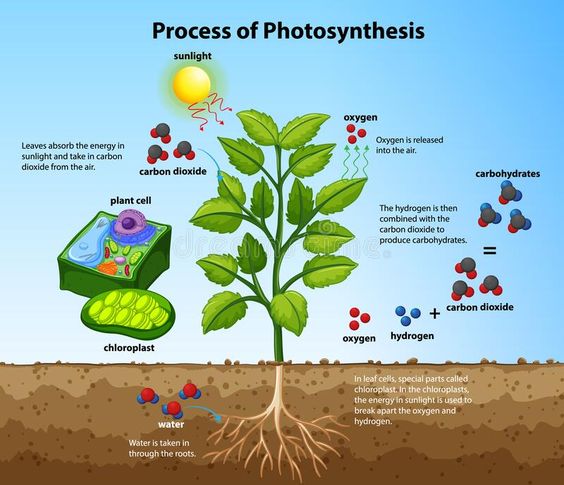
This visual representation includes the elements involved during photosynthesis, like carbon dioxide, hydrogen, oxygen, water, chloroplasts, carbohydrates, and sunlight.
Learn More: Dreams Time
2. Photosynthesis Relay Game
This fun, hands-on activity is a great way to reinforce learning about the photosynthesis formula. This game can be simplified or made harder, depending on the students’ age. All you need are two pieces of green construction paper, a copy of the pattern page, four envelopes, and two flashlights.
Learn more: Ellen Mchenry’s Basement Workshop
3. Worksheet to Test Your Students’ Knowledge of Photosynthesis
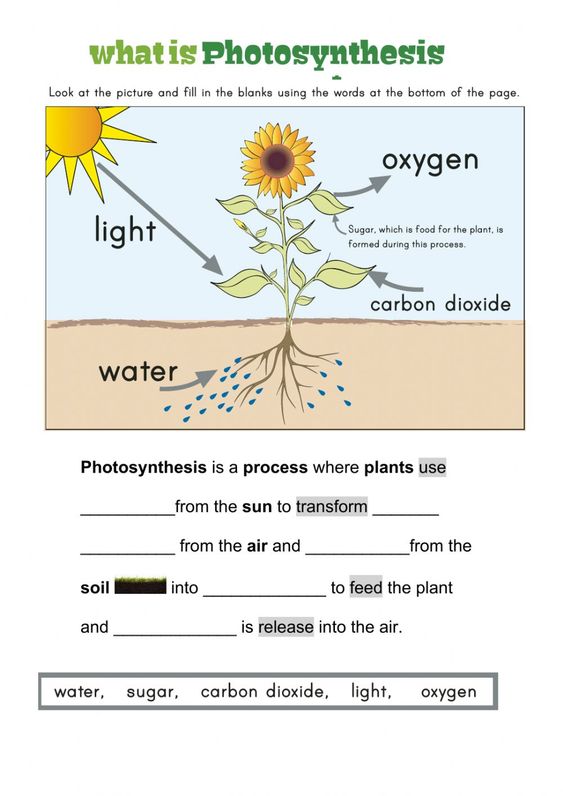
This engaging worksheet activity will help your students understand the concepts of photosynthesis.
Learn More: Live Worksheets
4. Fun Video To Help Your Students Understand The Formula For Photosynthesis
This engaging video by the Amoeba Sisters perfectly explains all the elements involved in photosynthesis and the formula for photosynthesis.
Learn More: Amoeba Sisters
5. Experiment To Measure The Rate of Photosynthesis
This hands-on activity will allow your students to explore and discover the importance of sunlight and carbon dioxide during the process of photosynthesis. You’ll need baking soda, a plastic syringe, fresh spinach leaves, a hole punch, plastic cups, a timer, and a light source.
Learn More: Photosynthesis
6. Experiment To Determine Which Trees Produce The Most Oxygen
This fun activity will help your students to understand how leaves create oxygen and the chemistry behind photosynthesis. For this experiment, you will need small containers of the same size, several types of leaves, and a timer.
Learn More: STEAMsational
7. Learn About Pigments, Chlorophyll, And Leaf Chromatography
Chromatography is the process of separating a mixture by passing it through another medium. In this experiment, your students will learn about chlorophyll in leaves, which gives leaves their bright green color, and how it changes to a different color in Autumn. You will need rubbing alcohol, coffee filters, mason jars, craft sticks, tape, scissors, and colorful leaves.
Learn More: Little Bins for Little Hands
8. Observe The Photosynthesis Process in a Spinach Leaf

In this experiment, your students will observe the photosynthesis process taking place, when you provide the spinach leaves with carbon dioxide, and exposure to sunlight. The leaves will release tiny oxygen bubbles. You’ll need fresh spinach leaves, a hole puncher, baking soda, dish soap, a plastic syringe, 2 clear cups, a measuring spoon, and access to sunlight.
Learn More: Clearway Community Solar
9. Learn All About Cellular Respiration
On the opposite end of photosynthesis is cellular respiration. We use the energy (glucose), and oxygen that plants release during photosynthesis, to create a form of energy, where we then release carbon dioxide and water, which plants need to make their own food, and so the cycle continues.
For this cellular respiration review activity, you’ll need straws, 150 ml beakers, rubber bands, plastic wrap, bromothymol blue indicator solution, distilled water, a stopwatch, baking soda, and distilled vinegar.
Learn More: Science Buddies
10. Learn About a Plant Cell’s Structure and Functions
This yummy, fun activity can be used for students in all grade levels and will teach your students all about the plant cell, and the different components that make up the cell.
Learn More: Research Parent
11. Fun Digital Lesson Bundle With Activities To Teach Concepts of Photosynthesis
This digital resource will help you save hours of lesson prep with its engaging resources and photosynthesis lessons.
Learn More: Glitter in Third
12. Hands-on Activities to Promote The Understanding of Photosynthesis
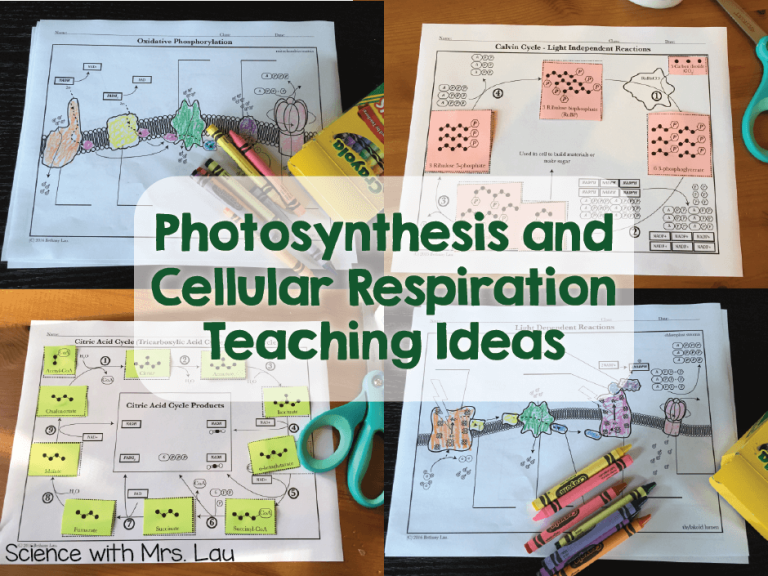
These printable resources will help solidify your students understanding of photosynthesis, cellular respiration, and all the elements and processes involved.
Learn More: Science and Math with Mrs. Lau
13. Make Your Own Plant Cell
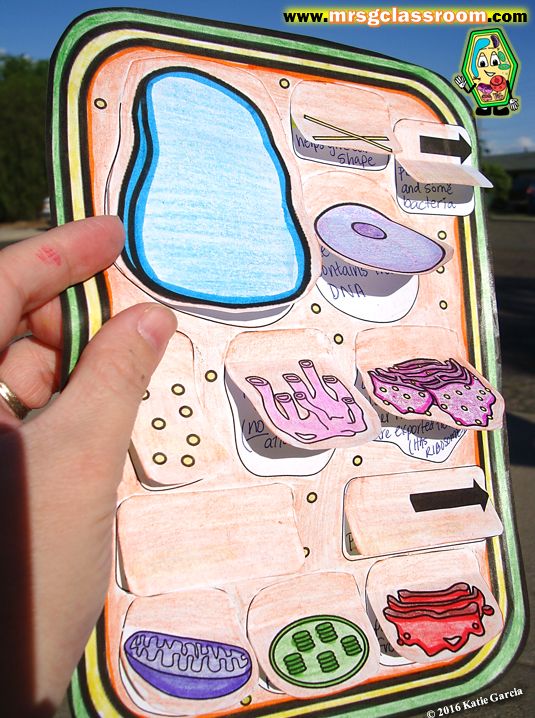
With this fun printable, your students will be able to create their very own plant cell and learn about all of the components and their names.
Learn More: Mrs. G’s Classroom
14. Fun Craft to Demonstrate Photosynthesis
This beautiful craft will make learning about the components of photosynthesis more fun! This free printable is an easy way to review your students’ knowledge or to introduce the topic to them. It can be modified to use with students of all ages by adding to it or making it easier.
Learn More: 10 Minutes of Quality Time
15. National Geographic’s Resource Library Will Teach Your Students All About Photosynthesis
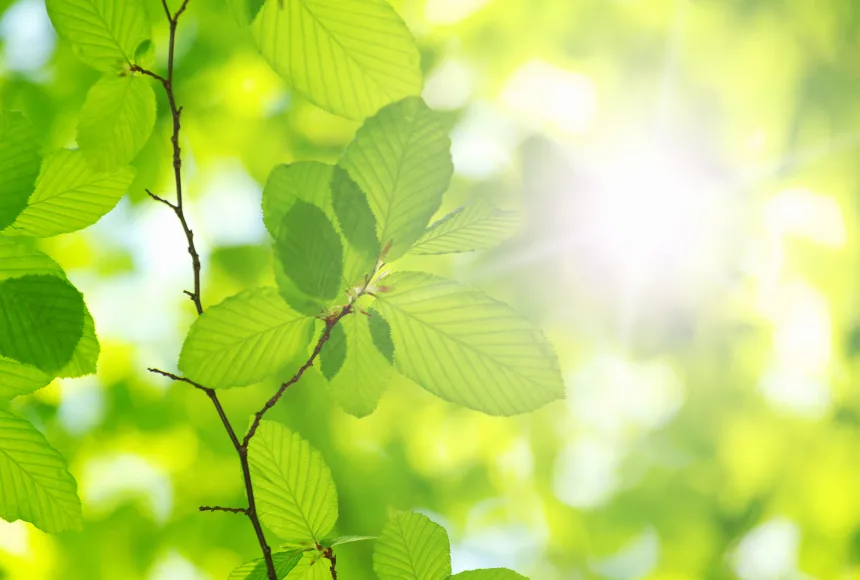
This Encyclopedic entry will teach your students all about chlorophyll, the process, light-dependent reactions, and different types of photosynthesis.
Learn More: National Geographic
16. Build a Working Photosynthesis Model
This activity is great for the upper grades or to challenge your students to delve deeper into the process. For this working model, you will need a lightbulb and accessories to make it work, card stock, a plant, labels, and soil.
Learn More: Craft Piller
17. 3-D Photosynthesis Tree Model
This fun project can be done at home or in class. It will help your students understand which parts of the plants perform which processes.
Learn More: Siena Homework
18. Video Lesson About Photosynthesis And Respiration
This video lesson explains the concept of photosynthesis and respiration and includes real-life examples and illustrations for easy retention.
Learn More: Moo Moo Math and Science
19. Online Resources to Teach Photosynthesis
This online resource contains explanations, background information, opportunities for exploration, and making connections.
Learn More: Kids Gardening
20. 5 Tips For Teaching Photosynthesis
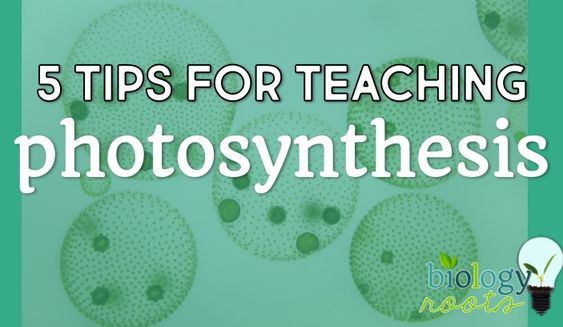
These 5 tips can help you successfully teach the complex process of biochemical reactions, independent reactions, and the carbon cycle which are all involved in photosynthesis and cellular respiration.
Learn More: Biology Roots
21. Photosynthesis in Aquatic Plants
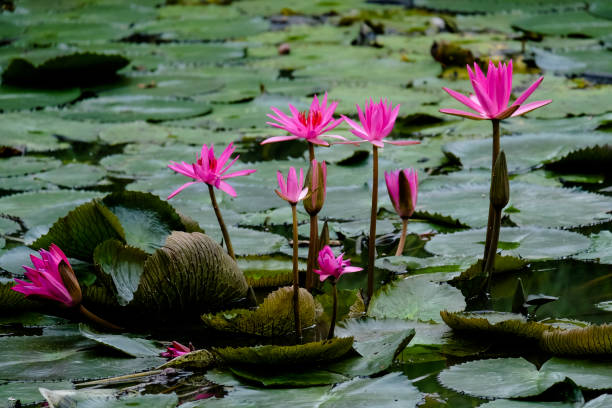
This resource will help your students understand how photosynthesis takes place in aquatic plants and the importance of aquatic plants in our everyday lives.
Learn More: Carolina
22. Play a Carbon Cycle Game
This fun game will solidify any knowledge that your students have on photosynthesis, cellular respiration, and the carbon cycle. Use it as an introduction to the topic, or to end your lesson. No matter when you use it, it is sure to make learning fun.
Learn More: Holding in Place
- Skip to main content

Bright in the Middle
Rigorous and Fun Science Activities

7 Photosynthesis Activities to WOW Your Middle School Students
Middle School Science , WOW Factor Lessons
Are you looking for some fun photosynthesis activities for your middle school science classroom? Whether you are introducing photosynthesis, teaching it, or looking for some fun extension activities, this is the post for you. Let’s bring the WOW Factor to your science classroom!
Plants need energy to survive. They are living organisms! Photosynthesis is the process that uses sunlight, carbon dioxide, and water to make glucose (sugar) and oxygen. This is used by the plant to create energy!
In this post, I share some photosynthesis activities to introduce this fun topic to students to help them become internally motivated to learn. Second, I share an interactive lesson to help students learn the content without all of the overwhelm that comes with so much content. Finally, I share some fun photosynthesis lab activities and other things to help extend their knowledge on this topic!
Check out the photosynthesis teaching resources below!

Photosynthesis Activities for Introduction – WONDER
WONDER activities are super important to do before diving into a lesson. Why? Well, this is because you want your students to become internally motivated to learn. If they actually want to learn, the rest is a piece of cake! Here are three different WONDER photosynthesis activities to try before diving deep into the content. You can choose to do one, two, or all three!
Leaf Stomata Lab
When we look at a plant, we see beauty, but we don’t see everything that is there. There is so much more to a plant than what we can see with our naked eye.
Giving students a chance to explore some microscopic aspects of plants before learning about photosynthesis can be really powerful.
You’ll need:
- clear fingernail polish
- a microscope
- microscope slides
- packing tape
You’ll need this for each group if your students are working in groups.
- Grab a leaf and paint a thin layer of the clear fingernail polish on the underside of the plant leaf. Let it dry.
- Take a piece of packing tape and place it on top of the underside of the leaf. Be sure not to get any fingerprints on the area that will be on the leaf. Press down on the side that the fingernail polish is on.
- Remove the tape and press it on the slide. Cut off any excess tape.
- Place this under the microscope. You will be able to see the stomata impressions.
Here’s a video that does a great job explaining. It’s a little quiet, so just turn up the volume a bit.
Have a Snack
I’m telling you, if you have followed my posts for any amount of time, you’ll know that I love to incorporate food into the classroom when I can! It’s just the way to a middle school student’s heart! This will be one of the most popular photosynthesis activities for introduction!
So, what kind of snack? Any! So, the point of this would be to have a snack, talk about how it gives us energy, and then ask students, “How do plants get their energy to survive and thrive?”.
From there, you can see what they already know about photosynthesis. It’s a great conversation starter for sure!
In our state standards, photosynthesis is taught in multiple grade levels, each grade building on another. Your students may already know so much, and this is a great way to get their brains back focused on the topic!

Go Outside and Explore Plants
This is another way to activate prior knowledge. If you don’t have the time and the means to explore the stomata at the microscopic level, this is a great alternative to get students thinking about what microscopic parts a plant may have.
Just take a quick walk outside. Explain to students that plants need energy, and they make it themselves. Students can explore different plants to brainstorm how plants may do this!
I believe that anytime you can get students moving and outside, it’s a great day!
Photosynthesis Interactive Lesson
Interactive lessons are great to teach a lesson! They help reduce student cognitive load by incorporating the 7 steps to help students retain information !
If students are given too much content at one time, they end up not learning anything at all. This is why it’s important to use strategies such as highlighting important information, segmenting information and allowing students to process before moving on, and taking out unnecessary information. Taking these steps, and more, helps students to better grasp the material.

In this photosynthesis interactive lesson, students will learn about cellular metabolism, ATP, stomata and guard cells, the photosynthesis formula, chloroplasts, chlorophylls, and so much more!
Inside of the lesson, there are activities along the way to help students process the information. These activities include an anticipation guide, drag-and-drop activities, text box activities, and more! Skip the photosynthesis activity sheet and try it out!
You can learn more about this resource in the Bright in the Middle Shop or on TPT.
Here are some other related interactive lessons!
Photosynthesis, Respiration, and Transpiration
Photosynthesis and Cellular Respiration
Photosynthesis Activities to WIDEN Knowledge
So, your students have learned a whole lot about photosynthesis, but there is still more time to extend their knowledge. Maybe you’re working on a photosynthesis 5E lesson plan, and you need some elaborate ideas! Here are three you can check out for photosynthesis.
Lego Photosynthesis
I have not tried this out myself, but it seems to be all of the rage, and it looks so much fun!
Here is a video I found to explain it! It’s much easier to show you than to explain it!
Pretty much, you’ll have different Legos to represent different elements. For example, you’ll have a small yellow block to represent hydrogen, and a longer red block to represent oxygen. You then connect them together to make elements, such as water.
This is a great way to model the formula!
Here are some instructions . I love it!
*You can also use paper pieces if purchasing the Legos doesn’t work out! You can even have students cut their own out of construction paper to save you time!

Photosynthesis Comic
Another great WIDEN activity to do with any topic is to have students to create a comic to apply their knowledge, and even learn more in the process.
Students can brainstorm a way to tell a story about the photosynthesis process. They can do this alone or in groups.
The next step will be to create their masterpiece! You can find a comic strip template to make life a little easier. Canva has a lot of templates that can be printed, or students can create their comic digitally!
This is a great way to bring art and writing into your science classroom!
Interactive Assessment
This is another neat interactive that I found by Virtual Science Teachers. It’s a review of photosynthesis with a final slide that your students can screenshot once they finish! It’s a nice alternative to a photosynthesis review worksheet.
It guides students through the process and provides a nice review if you are looking for a WIDEN activity that is quicker to complete.
Which photosynthesis lesson ideas will you choose?

Reader Interactions
Leave a reply cancel reply.
[…] Photosynthesis […]
9 Photosynthesis Lab Experiments for Your Class

Photosynthesis is one of the fundamental processes that occur in living organisms, particularly in plants. Understanding photosynthesis helps students appreciate the role of plants in the biosphere and their significance in sustaining life on earth.
Teaching this topic in the science classroom helps students develop a deep understanding of the natural world, its complexity, and its interconnectedness. It also helps prepare them for future studies in biology, ecology, and other related fields. We’ve outlined both in-person experiments and virtual labs you can use to teach photosynthesis!
1. In-person lab: Measure rate of photosynthesis in spinach leaves
Prepare a solution of water and sodium bicarbonate by dissolving 1 g of baking soda in 1 liter of water. Collect several spinach leaves and place them in a beaker of water for a few minutes to hydrate them. Fill several test tubes or small beakers with the sodium bicarbonate solution. Place spinach leaves in each test tube or beaker, ensuring they are fully submerged. After 5 minutes, measure the amount of oxygen produced by the spinach leaves using a Vernier LabQuest or other data-logging equipment.
2. Virtual lab: Pigment Extraction
In Labster’s simulation, Pigment Extraction: Use photosynthesis to produce biofuel and reduce pollution , Roxy, the leader of a team of engineers, will take students on a journey over the sea and show them the most problematic facilities are the coal power plant and the fish farm. To mitigate the problem, students will help create a sustainable plan for energy production using sunlight, heat from a coal power plant, and nutrients from a fish farm.

3. In-person lab: Chromatography experiment
This experiment provides a hands-on opportunity for students to develop important scientific skills, such as making observations, collecting and analyzing data, and drawing conclusions based on evidence. Extract pigments from different leaves using rubbing alcohol and filter paper. The resulting chromatogram will show the different pigments present in each leaf, such as chlorophyll, carotenoids, and anthocyanins. By separating these pigments, students can investigate their individual roles in the process of photosynthesis.
4. Virtual lab: Algae Pigment Analysis
In Labster’s online lab, Photosynthesis: Algae pigment analysis , students will help Roxy, the lead engineer in an environmental project, determine if dark-colored algae can do photosynthesis using green light. They’ll use the Hill reaction and spectrophotometry to measure electron flow and find out if the pigments in the algae can use green light for photosynthesis.

5. In-person lab: Oxygen production experiment
This is an activity used to investigate the production of oxygen during photosynthesis in aquatic plants. It involves placing an aquatic plant, such as elodea or Cabomba, in a beaker of water and exposing it to light while measuring oxygen levels in the water over time.
6. Virtual lab: Electron Transport Chain 1
In Labster’s digital lab, Photosynthesis: Electron transport chain , students will observe the inner workings of the electron transport chain inside a plant cell and learn about the process of photosynthesis. Watch electrons flow, and molecules move during each step of the electron transport chain. How can a photon of light be converted into chemical energy?

7. In-person lab: Starch production experiment
This is an activity used to investigate the role of light in the production of starch in plants. The experiment involves placing a leaf in the dark for a period of time to deplete its starch reserves and then exposing it to light to observe the production of starch during photosynthesis.
8. Virtual lab: Electron Transport Chain 2
In Labster’s simulation, Electron Transport Chain: A rollercoaster ride that produces energy , students will help a group of engineers figure out if a mysterious dark alga can do photosynthesis using green light and measure this process with the Hill reaction. If it is, your work will help create a sustainable plan using sunlight and pollution sources for biofuel production.

9. In-person lab: Light intensity experiment
This experiment helps to understand the interplay between light and photosynthesis and how plants adapt to different light conditions in their environment. Use a light source of varying intensities and measure the rate of photosynthesis in a water plant, such as elodea, using a probe or sensor. Observe how the rate of photosynthesis increases with higher light intensity up to a certain point.
Questions for reflection
- Were any of these in-person or virtual labs new ideas for you?
- Which one can you implement in your classroom?

Labster helps universities and high schools enhance student success in STEM.
Explore More
-transformed.png)
Labster's New Multi-Add Feature for LMS Courses: Streamlined Course Creation for Educators

How Labster’s Core Learning Architecture Enhances the Student Learning Experience

Introducing Math for Scientists: Empower Students with Essential Math Skills for Scientific Success

Discover The Most Immersive Digital Learning Platform.
Request a demo to discover how Labster helps high schools and universities enhance student success.
- WordPress.org
- Documentation
- Learn WordPress
- Members Newsfeed
22 Fun Photosynthesis Activities for Middle School
- Middle School Education

Introduction
Photosynthesis is a fascinating and crucial process that takes place in plants, algae, and some bacteria. It involves the absorption of sunlight, carbon dioxide, and water, which enables these organisms to produce glucose (energy) and release oxygen as a byproduct. Engaging in exciting photosynthesis activities can help middle school students better understand this vital biological process. Let’s dive into 22 fun photosynthesis activities suitable for middle schoolers!
1.Leaf Chromatography
Students can extract pigments from different leaves and use chromatography to separate and analyze their colors.
2.Plant Maze Experiment
Set up a plant maze to test how plants respond to light stimuli by growing towards it.
3.Photosynthesis Rap
Encourage students to write and perform a rap about photosynthesis to help memorize the process.
4.Water Lettuce Race
Create a mini aquaponic system using two tanks with water lettuce floating inside, one in darkness and one in light, to observe the difference in growth.
5.Leaf Stomata Imprints
Have students make imprints of leaf stomata using clear nail polish or glue to study the role of stomata in gas exchange during photosynthesis.
6.Oxygen Bubbles Experiment
Place an aquatic plant under different colored lights and measure oxygen bubbles to assess its rate of photosynthesis.
7.Carbon Dioxide Indicator
Use cabbage water or bromothymol blue as an indicator to visualize carbon dioxide consumption during photosynthesis.
8.DIY Solar Plant Cells
Allow students to create their solar cells using spinach leaves or other plants with high chlorophyll content.
9.Photosynthesis Board Game
Design a board game where players must collect resources such as sunlight, water, and carbon dioxide while avoiding hazards that hinder photosynthesis progress.
10.Algae Bead Oxygen Production
Create algae beads and place them under varying light conditions to examine their oxygen production rate.
11.Plant Pigment Art
Enourage students to explore plant pigments by creating colorful artwork using chlorophyll and other pigment extracts from leaves.
12.Grow-Your-Own Salad
Let students grow their vegetables using sunlight and nutrient-rich water, showcasing how plants convert energy into edible food through photosynthesis.
13.Explore Photosynthetic Bacteria
Study photosynthetic bacteria like cyanobacteria, which are capable of performing photosynthesis without chloroplasts.
14.Photosynthesis Charades/Pictionary
Play charades or Pictionary based on photosynthesis terminology to help students have fun with the subject matter.
15.Investigate C3, C4, and CAM Plants
Research the different pathways of C3, C4, and CAM plants and discuss their adaptations for various environments.
16.Construct a Photosynthesis Model
Use craft materials to build a 3D model illustrating the photosynthesis process at cellular and molecular levels.
17.Test Different Light Sources
Provide students with various light sources such as LED, incandescent, and fluorescent bulbs to test optimal light conditions for photosynthesis.
18.Photosynthesis in Action Group Mural
Invite students to collaboratively create a large mural that embodies everything they have learned about photosynthesis.
19.Soil vs. Hydroponics Experiment
Test the rate of photosynthesis in plants grown in soil and hydroponic systems by measuring each plant’s growth over time.
20.Virtual Biomes Exploration
Use technology like virtual reality or online resources to explore various biomes around the world and learn about unique plant adaptations in diverse environments.
21.Photosynthesis Cookoff
Challenge students to create recipes using only ingredients produced due to photosynthesis as a way to demonstrate its importance to human life.
22.Photosynthesis Debate Club
Related Articles

Starting at a new school can be an exciting yet nerve-wracking experience…

Introduction: As middle schoolers transition into more independence, it's crucial that they…
1. Unpredictable Growth Spurts: Middle school teachers witness students entering their classrooms…

Pedagogue is a social media network where educators can learn and grow. It's a safe space where they can share advice, strategies, tools, hacks, resources, etc., and work together to improve their teaching skills and the academic performance of the students in their charge.
If you want to collaborate with educators from around the globe, facilitate remote learning, etc., sign up for a free account today and start making connections.
Pedagogue is Free Now, and Free Forever!
- New? Start Here
- Frequently Asked Questions
- Privacy Policy
- Terms of Service
Are you sure you want to delete post?
This post cannot be restored anymore.
- Registration
Don't you have an account? Register Now! it's really simple and you can start enjoying all the benefits!
We just sent you an Email. Please Open it up to activate your account.
I allow this website to collect and store submitted data.

Make STEM Proud
Photosynthesis activities: my 4+ favourites
Photosynthesis can be a tricky subject. Sometimes, students don’t even know what an atom is when they start learning about photosynthesis (or at least that’s true in my class), so it’s complicated to introduce them to concepts such as reactions, molecules, and other important concepts.
That’s why I’m recommending you some photosynthesis activities, because I have tried and tested them and they have proven to be valuable for me.
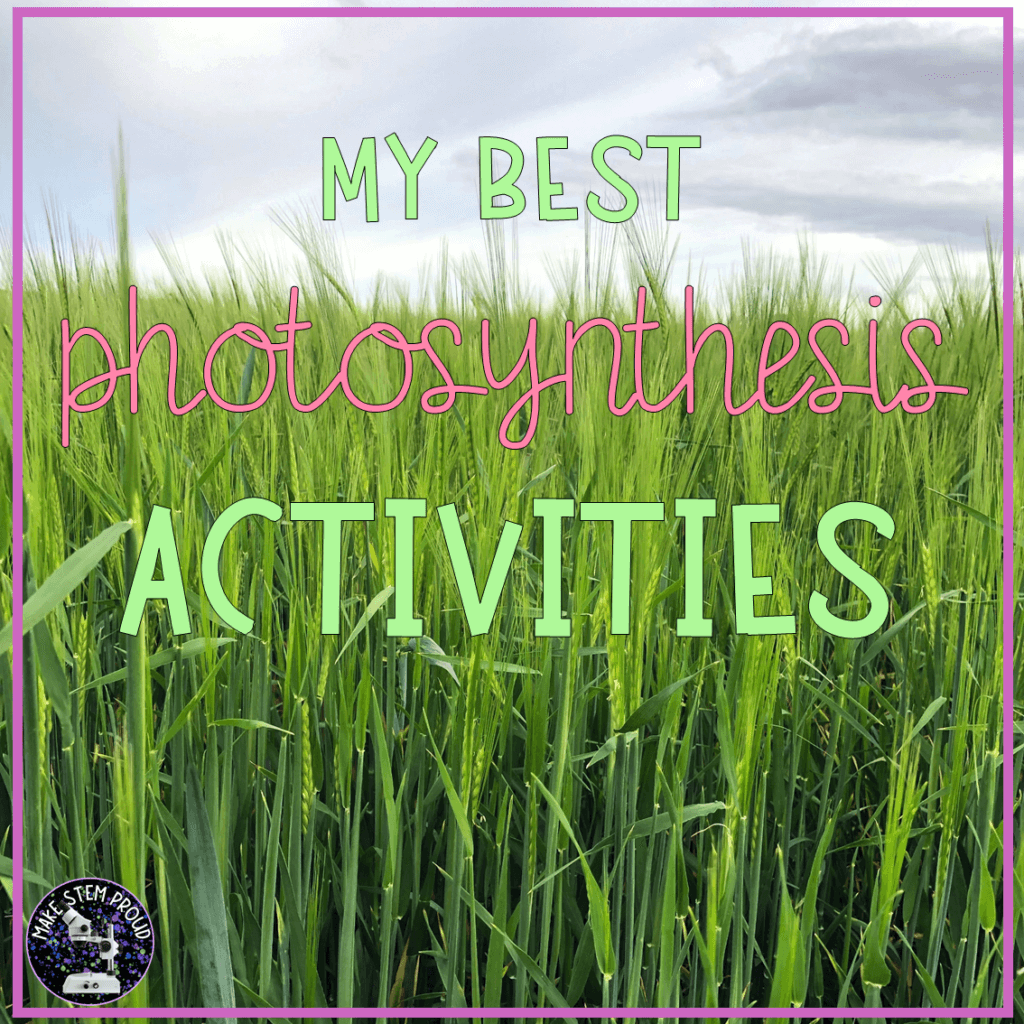
Photosynthesis activity #1: Stomata observation
The first of the photosynthesis activities I can recommend to you is a lab activity . One of my favourite things to do with my students is have them look under the microscope. Their faces light up when they look through the microscope.
The activity for stomata observation is super easy (that’s why I haven’t created a specific blog post).
I would use this as an introductory activity to plants, and specifically to leaf structure. I would do this activity and then start a socratic discussion about what exactly it is that they are seeing, what that structure might be used for…
You will need:
- Any leaf (I have tried a couple and they both worked)
- Transparent nail varnish
Steps to follow
1- On the underside of the leaf, paint a section of the leaf with the transparent nail varnish
2- After drying the nail varnish, paste some cellotape over the sections you painted
3- Lift off the cellotape and stick it onto a microscope slide
4- Observe the slide under the microscope
Photosynthesis activity #2: leaf disk flotation lab
The idea of this lab is that you make a study of different variables in photosynthesis. This is a popular lab to do, and it’s very easy, it has cheap materials, and it’s a good example of photosynthesis.
There is a complete blog post detailing the instructions , that you can visit here:
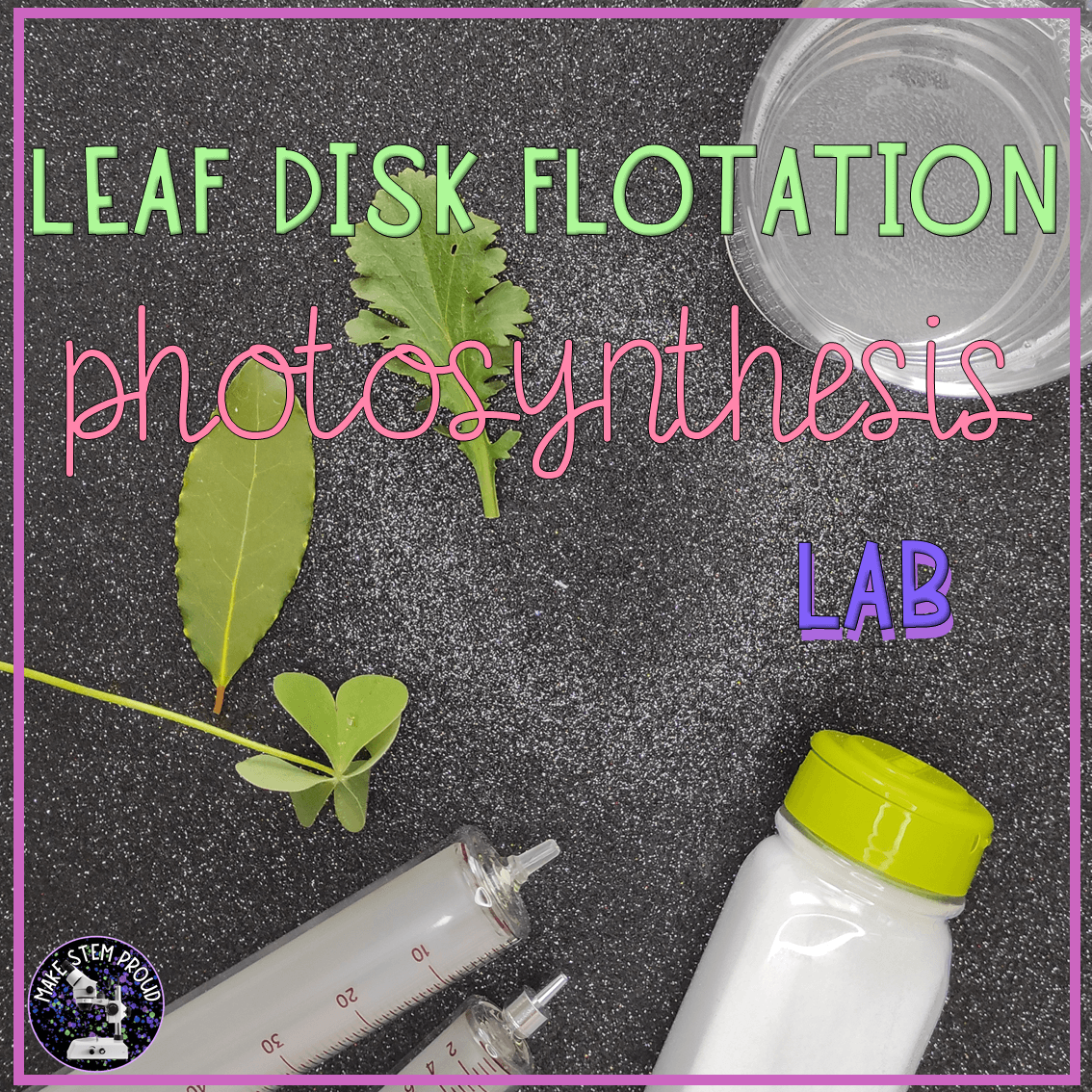
I absolutely recommend you use a lab like this in your lessons, to make sure students can see the results of photosynthesis in a clear way. You could use this activity as an introduction to the photosynthesis formula.
Photosynthesis activity #3: The circle of life
After you have introduced the formula, you can walk them through the following photosynthesis activities.
I had my students draw it in their notebook as they received the lecture from me, and this free resource from TpT was nearly perfect. If it were not nearly perfect, I would not be including it in my roundup.
The only thing is that the reaction is not adjusted, so I took the opportunity to get out the following two activities.
Photosynthesis activity #4:
In this activity students can adjust the reaction, and visualize each of the components . You can assign this activity directly to your students. It’s excellent.
This last simulation is the «plus». It’s what I put as a pickle in my class, so they can pick that activity to do as a voluntary assignment.
If you also want to do this, you can access the slides I use to do the «mustard, ketchup, pickles» in my class.
If you want the images I use in my slides, you can sign up to my email list.
Publicaciones Similares
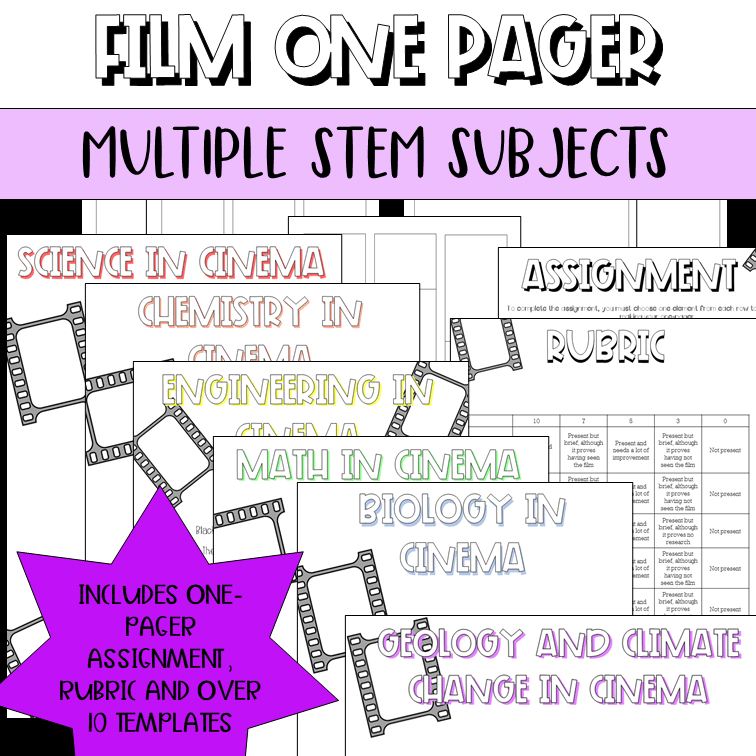
Science films in the classroom: one pager!
Want to teach your students using science films in the classroom? Teach them critical thinking of science fiction films, by using a one pager!
Actividades de halloween para ciencias
Actividades de Halloween para ciencias: biología y geología y física y química en secundaria. ¡Te propongo unas cuantas ideas para cualquiera!
DIY Chemistree
If you need chemistry christmas decorations, you can´t go wrong with this DIY chemistree. It comes with the paper dice downloads.
Laboratorio de ciencias: reglas y material
Si quieres ideas sobre cómo enseñar a los alumnos a utilizar el laboratorio de ciencias, y su equipamiento, aquí tienes.
Prácticas con microscopio: observar protozoos
Si quieres prácticas con microscopio para biología de 1º de eso, aquí te cuento mis secretos sobre cómo ver protozoos al microscopio.
How to calculate percentage of oxygen in air: easy lab
If you need an easy earth science lab to do with the atmosphere, here is a simple one on how to calculate percentage of oxygen in air.

IMAGES
VIDEO
COMMENTS
These 22 fun and interactive lessons, visual activities, lab activities, crafts, and experiments will help your middle school students understand the process of photosynthesis, the elements involved in this process, and the importance of photosynthesis to plants as well as to humans and animals.
In this photosynthesis interactive lesson, students will learn about cellular metabolism, ATP, stomata and guard cells, the photosynthesis formula, chloroplasts, chlorophylls, and so much more! Inside of the lesson, there are activities along the way to help students process the information.
We’ve outlined both in-person experiments and virtual labs you can use to teach photosynthesis! 1. In-person lab: Measure rate of photosynthesis in spinach leaves. Prepare a solution of water and sodium bicarbonate by dissolving 1 g of baking soda in 1 liter of water.
Let’s dive into 22 fun photosynthesis activities suitable for middle schoolers! 1.Leaf Chromatography. Students can extract pigments from different leaves and use chromatography to separate and analyze their colors. 2.Plant Maze Experiment. Set up a plant maze to test how plants respond to light stimuli by growing towards it. 3.Photosynthesis Rap
Discovering photosynthesis: which colour of light is best for growing plants - green, red or white. [P] Must plants have energy from the sun to live? [E] How much sun does a seed need to sprout? [E] What need plants in order to grow? [P] How do plants make food (photosynthesis basics)? [E] [E] [E] What is Transpiration? [E] [E]
Photosynthesis can be a tricky subject. Sometimes, students don’t even know what an atom is when they start learning about photosynthesis (or at least that’s true in my class), so it’s complicated to introduce them to concepts such as reactions, molecules, and other important concepts.